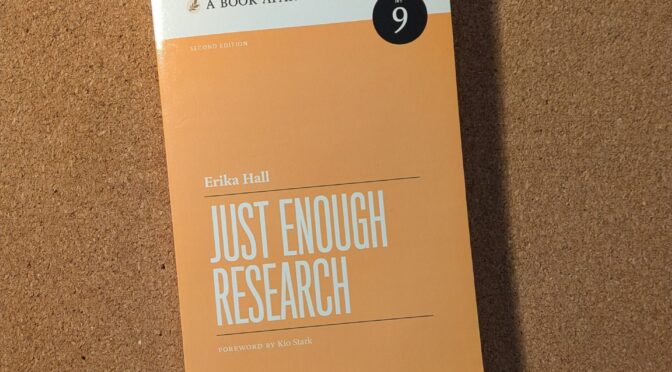When I bought Think Like a UX Researcher, the related book suggestions at the bottom of the page included Just Enough Research, by Erika Hall. So I bought it and read it from time to time.
As the title suggests, it starts from the question we sometimes ask ourselves, “how much research is enough“? There’s always the feeling that we could’ve researched a bit more, talked to more people, analysed the data a bit more deeply. But Hall argues that there’s a moment of “the click”, when the pieces of the jigsaw fall into place. We have to learn to listen to that sound.
One key aspect that helps us trust the moment to stop and say “that’s enough” is the fact that modern (digital) design is always iterative. Changes in the market, regulations, technology, user behaviours, and attitudes all indicate that we’ll soon have to start researching again.
She adds some great anecdotes and clear definitions to defend that we must perform research early in projects. We all know some stakeholders who need to be reminded of these:
The second most expensive kind of usability testing is the
kind that you put off until very late in the process, when you
risk finding out that there are huge usability problems that
will be very difficult to fix.The most expensive of all is the kind your customers do for
you after launch by way of customer service.
We must try to avoid these situations by testing early – starting with competitor analysis, then using paper prototypes and sketches, moving on to proper prototypes, and continuing to test at every stage of development.
The book has separate chapters for specific research methods, from ethnography (the gold standard, where you immerse yourself into users’ daily lives) to interviews (“never ask what people want”, and “conducting a good interview is actually about shutting up”) and surveys (the most difficult research method of all, often misunderstood, misused and over-trusted).
To conclude, this book was a good addition to my recent reads, probably sitting between the Think Like a UX Researcher (more like stakeholder management) and Observing the User Experience (more like a manual or textbook). Hall also give us design leadership tips, like “[t]he most difficult part of usability testing is determining how it fits into your process as a decision-making input”, and recommendations such as “[b]uild usability practices into your workflow from the start, the same way you account for internal reviews of work in progress”.
Reference
Hall, Erika, 2019. Just Enough Research. A Book Apart, 2nd ed.
